



November 07, 2017
Earlybird reserve is now open for TBX2 until the end of November. Only 100 are available, and they are being reserved at a pretty steady pace, so please don't forget to reserve your TBX2.
Even though the earlybird reserve is already underway, I decided it's not too late to add a significant hardware improvement to TBX2. I shared about this on facebook last week and got positive response, and it's about time I added some details.
What's going on with MIDI and USB? Well, as many long-time MIDI users have noticed, in recent years, more and more MIDI keyboards are being made without DIN5 connectors, and instead ship with a USB Type-B connector. The reason for this is simple; it's more convenient for people who are working only within computer-oriented environments.
Yamaha and Casio have taken this action for virtually all of their consumer-level keyboards, leaving MIDI DIN5 connectors only on more expensive units. But even mid to high-end lines are being affected by this trend. For example, on the most affordable end of the Yamaha Clavinova keyboards, the NP-11 and NP-31 were both excellent options for use with TBX1. Both are standard MIDI devices having reasonable piano, organ, and harpsichord sounds, and support for GM microtuning. After only a few years, both of these keyboards were respectively replaced with USB-only models: the NP-12 and NP-32.
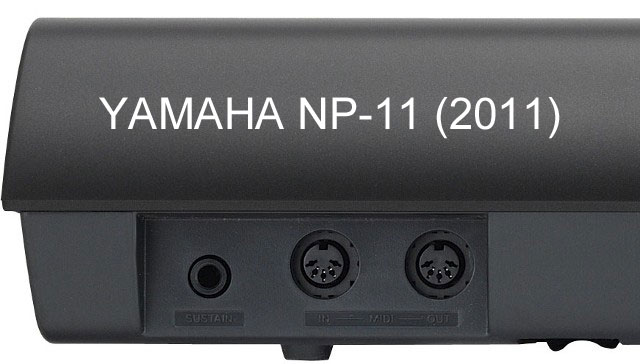
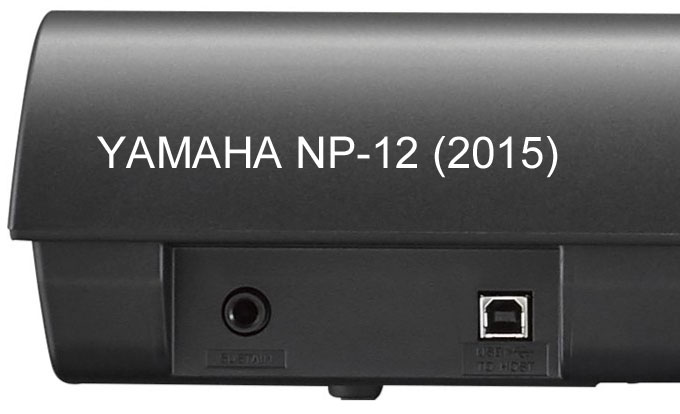

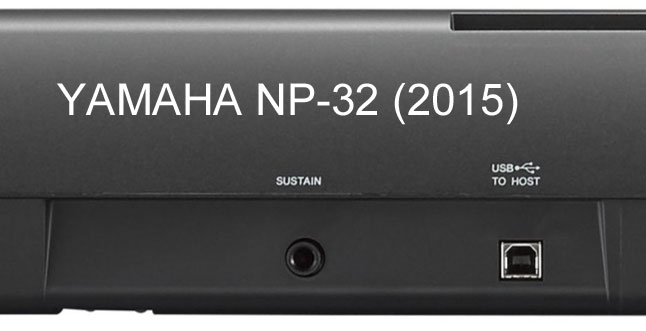
MIDI DIN5 on the earlier versions have been chucked in favour of USB. Why? Well, when an owner of an NP-11 wants to connect the keyboard to a computer, they need to use a USB-to-MIDI interface, a device which typically looks something like one of these:

So Yamaha is trying to make things easier by not requiring users to have these interface devices. Instead, these keyboards now have a USB-to-MIDI interface embedded inside them.
On one hand, embedding the interface seems reasonable, but that convenience comes with some serious consequences. Anyone working with standard MIDI equipment having DIN5 connectors cannot use the USB-only keyboard to connect directly to MIDI gear. That situation is exactly what the inventors of MIDI wanted to avoid. It's why they made MIDI a peer-to-peer system, so that any MIDI device can be connected to any other MIDI device. USB destroys that model, because USB is by design not peer-to-peer, but rather the opposite: Host-centric. In a USB environment, USB devices don't connect to each other; they connect to a host. The computer is the host, and USB devices require the host in order to connect. To be very clear about this, calling these devices which lack DIN5 connectors "MIDI" devices is actually pretty misleading. They are not in fact standard MIDI devices, because they break one of the cardinal design principles of MIDI: peer-to-peer functionality.
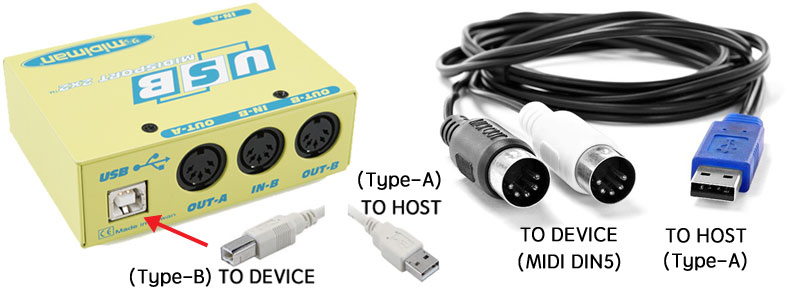
Notice the different types of connectors labeled in the above image. The USB jack on the MIDI interface at left is a square Type-B jack, which connects at the other end of a USB cable to a Type-A jack (the kind you find on your computer). This is the reason for the different types of USB jacks, so that the device and the host can be easily identified by which end of the cable goes where. The Type-B jack is a "device jack" and the Type-A jack is a "host jack". The only type of jack that is standard MIDI remains the DIN5, because in MIDI every device is a peer and there is no host.
The only way for a newly designed MIDI device to allow these now widely proliferated USB-only devices to connect is to include a USB-Host circuit. To do that would normally mean a bit of development, to select an appropriate chip and write firmware for that chip so that it can become a USB-Host, which is no simple task, and requires time and money. Luckily, a company in England called Hobbytronics has done this work already, and we are now working with their pre-programmed chip to add USB-Host functionality to TBX2.
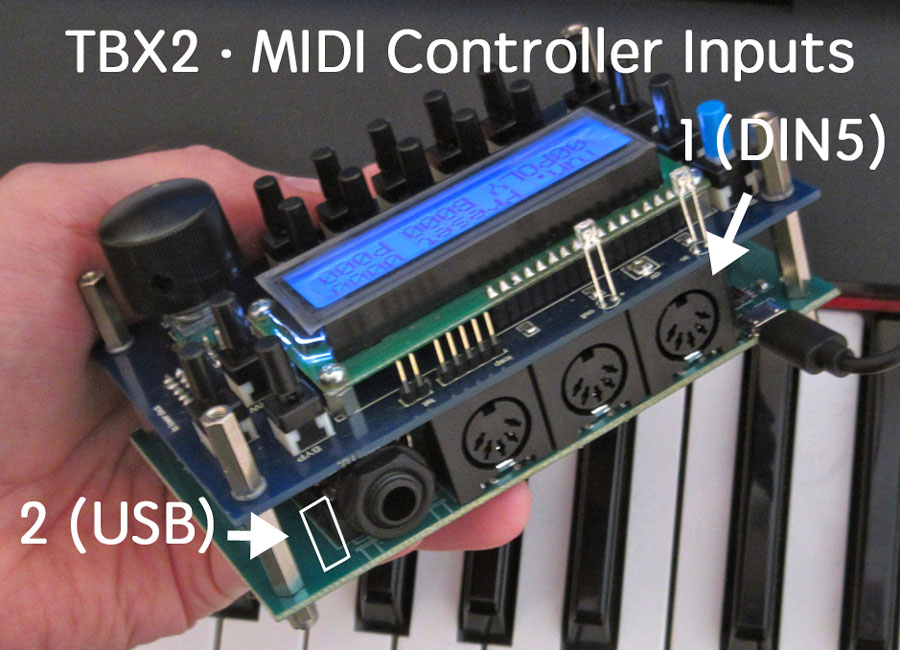
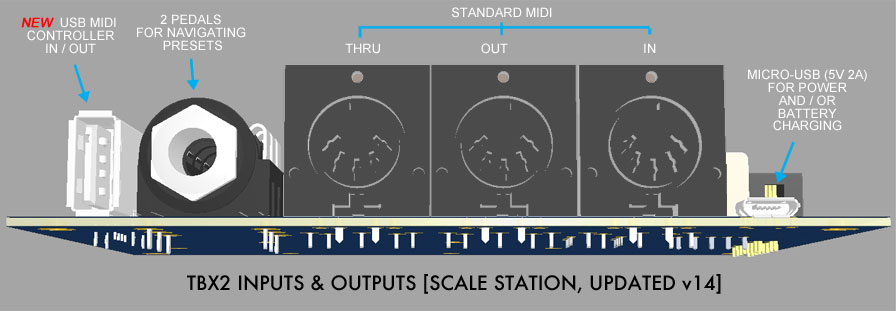
In case it isn't abundantly clear at this point, please note that this new jack on the left is not a USB-MIDI Interface jack. It is a USB Type-A connector, the same connector you find on your computer. That is because TBX2 will act as the USB host, the same way your computer acts as the USB host. To connect TBX2 to your computer for uploading tunings to the device, you will still need a MIDI Interface, connecting a MIDI cable to TBX2 through the standard MIDI IN DIN5 jack. This type of connection can't be done through the existing micro-USB jack on TBX2 because it is devoted to power and battery management only, and it can't be done through the USB Type-A jack because that will be dedicated to the USB-Host function. To add a USB-MIDI interface, we would have to add yet another jack (this time the Type-B) and yet another circuit with yet another chip running yet another firmware, consuming power, and taking up space. Luckily, since MIDI Interfaces are not terribly expensive, it really isn't necessary to include one inside TBX2.
Once this new jack is working, all those newer USB-only keyboards can be connected to TBX2, and that is no small advantage, since it includes literally hundreds of newer keyboard models. It means high-end piano keyboards like Roland's FP-30 and FP-60 will be able to connect and be retuned on-the-fly. It also means our very own U-PLEX can be plugged in and expanded to include all the features that TPX keyboards have built-in, and then some. In a future blog entry I'll do an in-depth study of how different keyboards can be retuned by TBX2.
Until then, don't forget to reserve your TBX2 now to get a 60 € discount on the pre-order. Earlybird reserve ends on the last day of November!
Best Regards,
Aaron
[ Showing 1 entry | Next entry | Show all entries ]